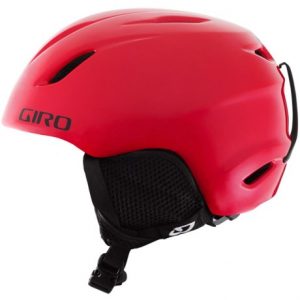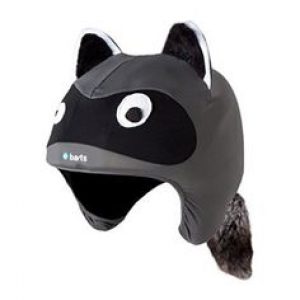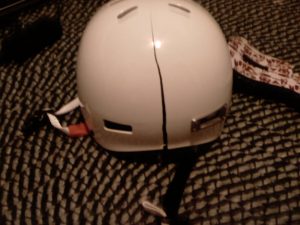Nowadays, kids’ ski helmets are not merely a safety mechanism—they’re full-fledged fashion and technology accessories. Bold patterns? Check. Ability to affix a GoPro? Check. Futuristic designs? Check. As a consumer, however, it can sometimes be difficult to cut through helmets’ flashy features and ensure that the helmet you are purchasing for your child is sturdy, safe, and will fully protect your child’s head in the event of an accident. Below, we’ve compiled a checklist of five factors to watch out for when searching for a kids’ ski or snowboard helmet. Adhere to them, and your child will have a well-fitting, cool-looking, and tech-savvy helmet. Happy skiing!
Look for the standard ski helmet safety certifications
In the United States, the ASTM F2040 is the most common certification for snow helmets—a blanket term that also encompasses helmets for nonmotorized recreational snow sports and snowboarding. This certification is an indicator that the manufacturer is producing safe, sound helmets that are appropriate for use in a given snow sport. It applies to helmets produced for kids as well as adults, keeping in mind that the primary purpose of a helmet is to prevent against severe injury. Figuring out whether a helmet has a ASTM F2040 certification isn’t tough—just check on the inside of a helmet for an ASTM sticker.
This is especially important when buying a ski helmet online, as it could be possible for a non-approved and non-certified helmet to creep into the buy box, especially if manufactured by an upstart company whose sole purpose is to sell goods online.

Get to know what a helmet is made of
Most skiers simply strap on their helmets and head off to the mountain without a thought of what their helmet is actually made of—and how it is constructed to protect them in case of a serious fall or accident. Helmets are specifically engineered to protect skiers’ heads and reduce / absorb impact. A helmet’s outer layer is known as the shell, and shields the head from knocks and sharp objects. In addition, it acts to distribute the energy of an impact across the entire helmet when contact is made. The shell works in consortium with the inner liner, which is made from EPS (or expanded polystyrene) foam. Again, the inner liner is specially designed to absorb impact and reduce the ultimate effect to the wearer. It is important to keep in mind that if you endure a serious fall, your helmet should be replaced immediately—as some of the helmet’s components may have been damaged. Now that you’re an informed shopper, you can examine kids’ helmets with a sturdy shell and inner liner in mind.
Consider add-ons for cold-skiing warmth!
Skiing is a chilly sport—so savvy helmet manufacturers are creating helmets with additional accessories that will keep the wearer toasty through their days on the mountain. If you’re venturing to a particularly cold mountain, try searching for a helmet with detachable ear pads or a detachable liner. These accessories will bring warmth to the wearer without adding extra bulk (like a hat would). Once the weather warms up, your child can simply detach the ear pads and liner if you like. They’re also easy to pop in the wash if they get dirtied during a day on the mountain.
Make sure the helmet fits!
Nothing is worse than enduring a day on the mountain with an ill-fitting helmet—whether it’s too tight on your head or uncomfortably loose. Therefore, it’s key that you get the size right! When you’re shopping for kids’ helmets, have your child bring

their goggles with them so that they can see how the helmet feels with them on. This will ensure that the helmet is comfortable on their head whether or not they are wearing googles along with it. To measure your child’s head size, you can simply try on helmets or measure their head with a tape measure if you are shopping online. Getting the correct head measurement is the first step in getting a good fit. But what actually constitutes a good fit? A properly fitting helmet should be snug on your child’s head—but not tight. If the helmet is able to rock from side to side on your child’s head, it means it is too loose. Furthermore, there should be no gap between the top of your child’s googles and their head. A helmet’s chinstrap / buckle is another component of helmet fit. A chinstrap needs to be fastened against the throat to minimize the possibility of it flying off in the case of impact. Again, the snug but not tight rule applies here—your child should be able to chew food without discomfort. Once you’ve gone down the checklist of helmet fit with your child, they can safely tackle the slopes!
Last, outfit cool ski helmet features
Safety comes first when searching for a kids’ helmet—but that doesn’t mean your child can’t be safe and stylish. There’s a whole host of helmet features that will make your child’s time on the mountain more enjoyable, comfortable, and fun.
-
- Vents are a common helmet feature that bring cool air in and take warm, humid air out. They ensure that your helmet stays well-ventilated throughout the course of your day and that it never becomes too hot. Some helmets even come equipped with adjustable vents, enabling the wearer to adjust their airflow with the flip of a lever. As helmet technology has evolved over time, vents have become somewhat of a must-have for helmets.
- Compatibility with your ski goggles. If you combine a helmet and ski goggles from the same brand, they usually go out of tier way to make the goggles fit perfectly with the helmet. If you mix brands, be sure that they fit well together, such as having the right dimensions from side-to-side, or having the strong fit nicely in any strap holder that might be on the helmet.
- Camera mounts are an excellent way for your child to capture their time on the slopes—whether they’re stellar runs or epic wipeouts. Some helmets have mounts compatible with a GoPro, while others even come with their own built-in camera! No matter what kind of mount-equipped helmet you and your child choose, it’s a hassle-free way to document your mountain adventures. No awkward photo shoot necessary!
- Ski helmet covers. Kids and adults alike love to have fun with ski helmet covers. A good cover allows you to grab some attention and have some fun with your friend on the slopes. Just be sure that the cover doesn’t compromise the helmet’s function, such as get in the way of your goggles, or eliminate the ability for the helmet to breathe through the vents.
- Music is a key part of many skiers’ time on the slopes—they love hearing their favorite songs as they make their way down the mountain. Many kids’ helmets are now constructed with built-in speakers that allow wearers to seamlessly listen to music. Even if a helmet does not have built-in speakers, many are designed with the idea that the wearers will be wearing ear buds. Though kids may be immediately drawn to helmets with music features, it is key to keep the safety factor top of mind. Brand-new skiers may not yet possess the focus or control to listen to music and safely make it down the mountain. Therefore, use your best judgement when purchasing a music-powered helmet for your child.
- A case will keep your child’s helmet safe in the off-season—and retain the shine it had when you first bought it. Some helmets come with a case, while others do not and you’ll have to

An extreme example of a helmet crack. We recommend always buying new. purchase one separately—it depends on the manufacturer.
- Colors. The good news is that kids ski helmets come in all sorts of colors and designs. This should be the last thing you are worried about — safety and comfort absolutely come first — but many kids like a flashy helmet or one that matches. Once you have figured out the safety and fit, have some fun with the colors.
- Buy New. Hey, we are all for recycling, but we advise buying a new helmet instead of one on Craigslist or from someone you don’t know. You never know when it was made, if it meets today’s standards, and most importantly if it might have wear or a hairline crack that would affect its performance in a collision.
Are Used Ski Helmets OK?
When it comes to ski helmet, we strongly recommend buying new — unless you are using a hand-me-down helmet that has been in your household since it was new and is very lightly used. Used helmets could have hairline damage from falls, packing, or moves that you can’t see. When your child falls, you want the helmet to be fully-functioning and uncompromised. Additionally, it is hard to ever get the inside of a helmet that has been used extensively by another person to be completely clean. That brings us to….
How Long Does a Ski Helmet Last?
It is important to remember that a ski helmet is intended to be involved in just one crash before it is time to replace. Once you have crashed and your helmet has taken a good hit, it has done its job and much of the shell material is likely compromised. If you or your child have not crashed but a helmet is just aging, we recommend that you consider replacing after 3 years, and 5 year if it gets really lite use (as an one ski trip per year). Why? All the little wear and tear — hair product sweat on the inside, little dings against chairlift bars and gondola doors on the outside — add up and can begin to affect the integrity of the helmet.

Paul Miller is the Founder of Family Skier. He is an advanced skier and has extensive experience with family travel and ski schools. An accomplished skier, he has skied in 15 states and provinces and 6 countries. In addition to FamilySkier, his writing can be found on many ski-related websites, and as curriculum for many ski clubs in North America.




